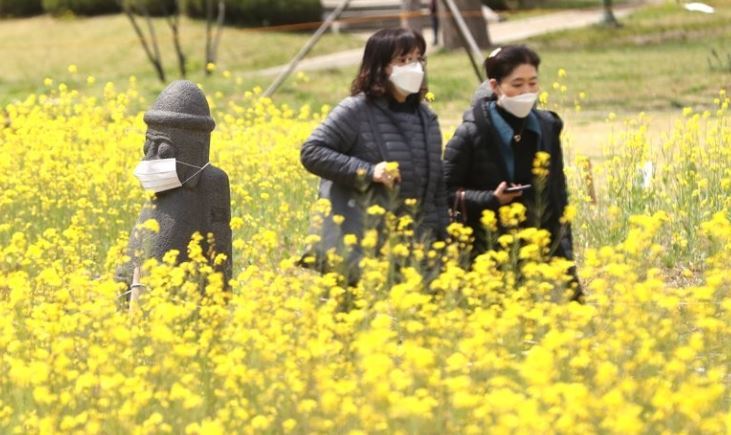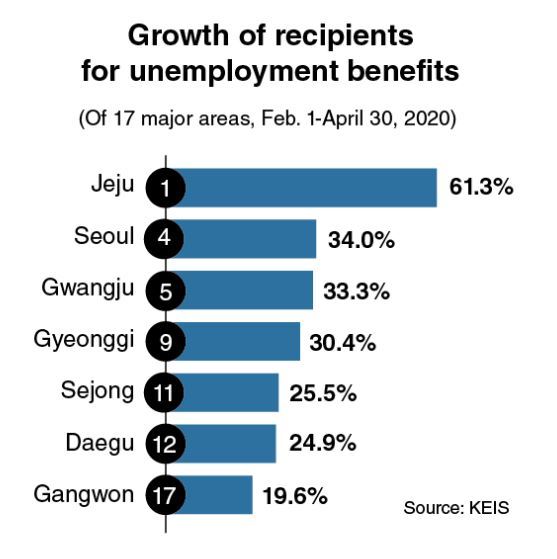[News Focus] Jeju Island No. 1 in jobless growth from COVID-19
Seoul, Incheon among 4 cities where unemployment payouts have increased the most
By Kim Yon-sePublished : June 23, 2020 - 14:28

SEJONG -- South Korea saw the number of recipients of unemployment benefits surge 30.4 percent to 660,464 in only three months in the wake of the novel coronavirus.
While the government paid more in benefits to those who lost their jobs in all 17 regions nationwide, data from the Korea Employment Information Service showed disparities among regions.
Jeju Province had 8,286 recipients in April, compared with 5,135 in January, when the first coronavirus case was reported in Korea. That is a 61.3 percent increase, the highest in the nation.
Self-employed businesspeople make up a high proportion of the province’s residents. Particularly over the past decade, many small retailers including coffee shop owners, have rushed from the mainland to the nation’s largest island.
“Apart from the microbusiness owners, a dominant portion of employees there are estimated to have been hit by the epidemic due to a sharp fall in the number of local and inbound tourists,” said a labor research analyst in Seoul.
Ulsan was next, with the number of recipients having increased 34.6 percent. Incheon stood at No. 3 with 34.1 percent and Seoul at No. 4 with 34 percent.

Seoul saw the number of unemployment benefits recipients increase from 94,191 in January to 126,281 over the corresponding three months.
Gwangju was No. 5 on the list with a 33.3 percent increase, followed by Daejeon with 32.7 percent, South Gyeongsang Province with 31.5 percent, Busan with 31 percent and Gyeonggi Province with 30.4 percent.
At No. 9 on the list, Gyeonggi Province had 169,673 recipients in April -- 25.6 percent of the nationwide total, 660,464 -- as compared with 130,023 three months earlier. The province is the nation’s most populous area.
Among the eight major cities, Sejong and Daegu posted relatively low growth in recipient numbers -- 25.5 percent and 24.9 percent, respectively. Of the 17 regions, Gangwon Province saw the most modest increase, 19.6 percent.
The KEIS has yet to make public a regional breakdown of its data for May. The Ministry of Employment and Labor said only that payouts for the jobless surpassed 1 trillion won ($823 million) for the first time in history during the month of May. However, the figure was tentative.
Meanwhile, data showed that benefits payouts have increased rapidly over the past decade, even aside from the aftermath of COVID-19.
In the early and mid-2010s, the government’s yearly payouts for jobless people ranged between 3.3 trillion won and 4.5 trillion won.
The figure recorded 4.67 trillion won in 2016 during the previous administration amid moderate growth in the volume of unemployment benefits, according to the KEIS figures.
The situation began to change in 2017 as the nation saw microbusinesses close en masse. Self-employed people accounted for about 25 percent of all working people and have faced a tight job market.
Unemployment benefits have increased sharply over the past three years, reaching 5 trillion won in 2017, 6.43 trillion won in 2018 and an all-time high of 8.07 trillion won in 2019.
The 2019 figure marked a 72.8 percent (or 3.4 trillion won) surge compared with 2016.
Further, compared with five years earlier -- in 2014, when benefits paid out amounted to 3.96 trillion won -- the 2019 payouts constituted a 103.7 percent increase.
Some government officials have argued that unemployment benefits payouts rose in proportion to the rise in the statutory minimum wage.
But critics, including online commenters, say the rapid growth in payments since the early to mid-2010s could suggest a dire situation in the hiring market during the Moon Jae-in administration. They cite the “extended-based” jobless rate, also called the de facto jobless rate, which includes the underemployed as well as the unemployed.
The extended-based jobless rate has remained above 10 percent since the Moon government took office in May 2017.
By Kim Yon-se (kys@heraldcorp.com)







![[Graphic News] More Koreans say they plan long-distance trips this year](http://res.heraldm.com/phpwas/restmb_idxmake.php?idx=644&simg=/content/image/2024/04/17/20240417050828_0.gif&u=)
![[KH Explains] Hyundai's full hybrid edge to pay off amid slow transition to pure EVs](http://res.heraldm.com/phpwas/restmb_idxmake.php?idx=644&simg=/content/image/2024/04/18/20240418050645_0.jpg&u=20240419100350)







![[KH Explains] Hyundai's full hybrid edge to pay off amid slow transition to pure EVs](http://res.heraldm.com/phpwas/restmb_idxmake.php?idx=652&simg=/content/image/2024/04/18/20240418050645_0.jpg&u=20240419100350)

![[Today’s K-pop] Illit drops debut single remix](http://res.heraldm.com/phpwas/restmb_idxmake.php?idx=642&simg=/content/image/2024/04/19/20240419050612_0.jpg&u=)